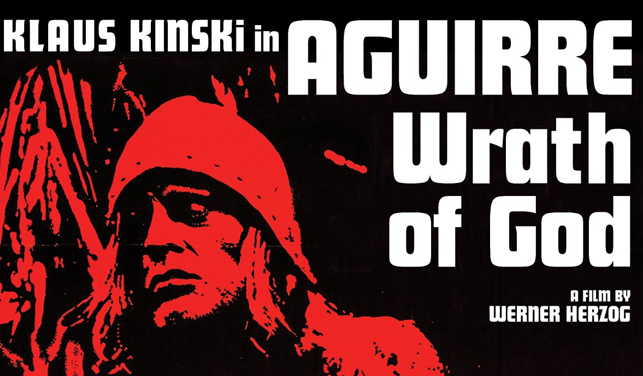
Aguirre, Wrath of God Review
 Werner Herzog is typically associated with the ‘New Wave’ of German filmmakers of the early 1970s alongside Wim Wenders, Volker Schlondorff, Hans-Jürgen Syberberg and Rainer Werner Fassbinder. But Herzog is a little different. The work of the other directors was more political and contemporary whereas Herzog dealt mostly with historical subject matter and his Aguirre, Wrath of God is a good example of that. His work prior to this was quite experimental (the bonus early shorts and experimental feature on the disc are examples of this). From early on in the film that experimental style comes across into mainstream cinema.
Werner Herzog is typically associated with the ‘New Wave’ of German filmmakers of the early 1970s alongside Wim Wenders, Volker Schlondorff, Hans-Jürgen Syberberg and Rainer Werner Fassbinder. But Herzog is a little different. The work of the other directors was more political and contemporary whereas Herzog dealt mostly with historical subject matter and his Aguirre, Wrath of God is a good example of that. His work prior to this was quite experimental (the bonus early shorts and experimental feature on the disc are examples of this). From early on in the film that experimental style comes across into mainstream cinema.
The opening lines of the film tells us that it is 1560 and that these are Spanish conquistadors in search of El Dorado (the mythical city of gold made myth by the local Indians to draw the conquerors into dangerous territory) as they make their way across the South American Andes. The opening shots are fairly lengthy as we see a mixture of natives, slaves and curiously dressed Spanish conquerors making their way down a misty and very steep path on the side of a mountain (actually Machu Picchu in Peru) to the haunting electro score by Popol Vuh that sews its way through the film as a repeated and haunting refrain. All these men look tired and worn down, looking strangely out of place in their surroundings much like the 19th Century figures in a Henri Rousseau jungle painting as they carry armour, canons and madonnas. Once they reach the bottom of the mountain and to the river it becomes clear that the whole party cannot carry on at this scale and the most effective way, rather than through the jungle would be by river. The leader of the group elects Don Pedro de Ursua and his wife lead the party with the war-like Aguirre (Klaus Kinski), who later overthrows Ursua as a traitor, his daughter, a troop of soldiers, a monk (the narrator) and slaves travel by rafts towards El Dorado. What they find up river are rapids, tribes of cannibals and increasing danger with Aguirre becomes growingly megalomaniacal bordering on insanity before his final collapse at the end of the film.
To anyone seeing this film for the first time its atmosphere and descent into madness will be both strange and familiar. Francis Ford Coppola was heavily influenced by this film when he made Apocalypse Now (which was also based off Joseph Conrad’s 1900 novel, ‘Heart of Darkness’ another tale about a journey through a jungle and down river which descends into madness). No mention is really given to this influence in popular culture in the accompanying essay booklet by Laurie Johnson. The atmosphere in both films is strange, they both have a narrator and the deeper both films go down river the further into madness the protagonists descend: the adventurers are attacked by cannibals, there is also an image of a boat in a tree in both films and so on. But it doesn’t end there. The problems filming in such conditions created a mad situation for the makers of both films with crew and cast alike facing dangerous rapids and becoming stuck in the mud in unhospitable conditions. Coppola’s experiences in his film are brilliantly re-told in the documentary on the making of the film, Heart of Darkness and therefore it is a shame that there is no accompanying Making Of documentary extra to Aguirre. At least the commentary by Herzog himself on the disc covers much of this. Famously the notoriously difficult Kinski had many a run in with the director that almost and allegedly did come to blows through the making. Yet there is no doubt that the close-up action and Kinski’s performance are outstanding as he slowly descends to this level of crazy as he becomes the ruler of nothing more than teeming monkeys and decries that he is the Wrath of God. Despite their clashes Kinski and Herzog would re-unite for several other films including Nosferatu (1979) and a similar film to Aguirre with similar perils, Fitzcarraldo (1981).
BFI have done themselves proud with this presentation (despite no Making Of film) with three rarely seen experimental films by the director which demonstrate some of his repetitive motifs (such as the repeat of a plane landing in the bizarre Fata Morgana) and an audio commentary by Herzog himself. The picture is clear and sharp with the right amount of grain and the presentation also comes with both the German and English soundtrack. However, although the original language is usually always preferable it is worth viewing in English too as this is how the film was originally recorded with German dubbed on after (Kinski famously asked for an astronomical post-synch fee and another actor voiced him instead) due to an international cast. The sound quality on the German version though is somewhat better.
Chris Hick
